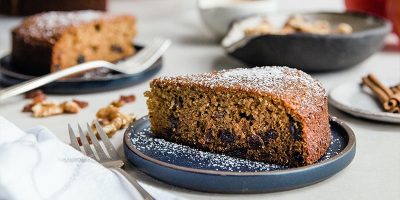History of Croissant: A Tale of Delicious Origins


In the realm of pastries, the Croissant stands as a revered and beloved treat, enchanting taste buds with its buttery layers and delicate flakiness. But what is the story behind this delectable creation? Let’s embark on a journey through time to uncover the fascinating history of the croissant. Legend has it that the origins of the Croissant can be traced back to Vienna, Austria, during the 17th century. The city was under siege by the Ottoman Empire, and after successfully repelling the invaders, the Viennese bakers wanted to commemorate their triumph. Inspired by the crescent moon, the symbol of the Ottoman Empire, they crafted a pastry in its distinctive shape called “kifli” or “kifla.”
Fast forward to the late 18th century, when Marie Antoinette, the Austrian-born queen of France, introduced the kifli to the French court. The French bakers, renowned for their culinary finesse, adopted and transformed the pastry into what we now know as the croissant. The crescent shape remained, and they perfected the art of creating flaky, buttery layers that would leave a lasting impression on pastry enthusiasts around the world.
Origin of the Croissant: From Vienna to Paris and Beyond
As the Croissant gained popularity in France during the 19th century, it quickly became an iconic staple of French bakeries. Its fame began to spread far and wide, captivating taste buds with its delicate texture and rich, buttery flavor.
The traditional Croissant is made from a laminated dough, a process that involves layering butter and dough to create a multitude of flaky pockets. This technique is what gives the Croissant its signature texture, with each bite revealing a delicate interplay of airy layers and indulgent richness. Over time, various regional variations of the Croissant emerged, each adding its own unique twist to this classic pastry.
Types of Croissant: Exploring Flavors and Variations
Almond Croissant
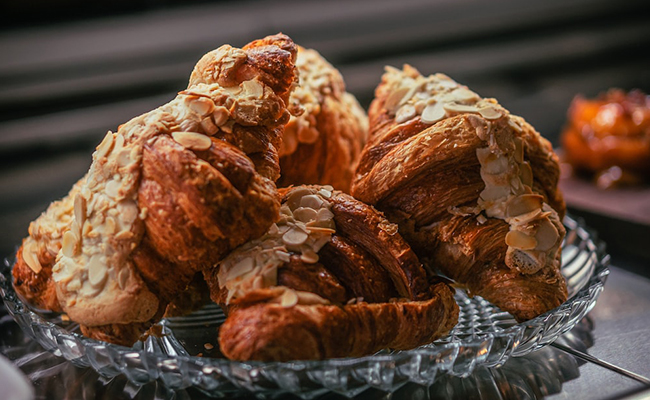

Indulge in a delightful variation that combines the flakiness of a Croissant with the nutty richness of almond cream. Topped with sliced almonds, it offers a textural contrast and a delightful hint of nuttiness.
Chocolate Croissant
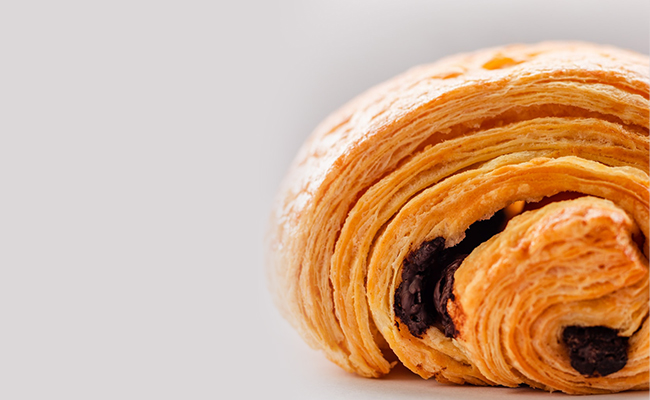

For those with a sweet tooth, the chocolate Croissant is an irresistible choice. Encased within the flaky layers is a generous filling of rich dark or milk chocolate, offering a heavenly experience with every bite.
Pain au Chocolat
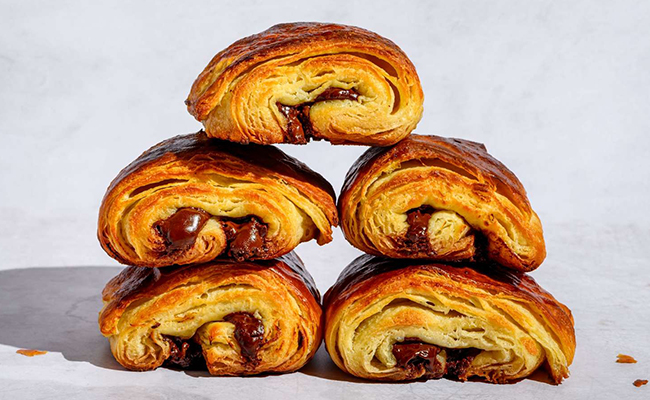

Similar to the chocolate croissant, the pain au chocolat takes a rectangular form and is filled with chocolate. This variation allows for a higher chocolate-to-pastry ratio, perfect for those seeking an intensified cocoa experience.
Ham and Cheese Croissant


If savory delights are more to your liking, the ham and cheese Croissant is a satisfying choice. With layers of thinly sliced ham and melted cheese tucked within the flaky embrace of the croissant, it offers a savory symphony of flavors.
Fruit-Filled Croissant
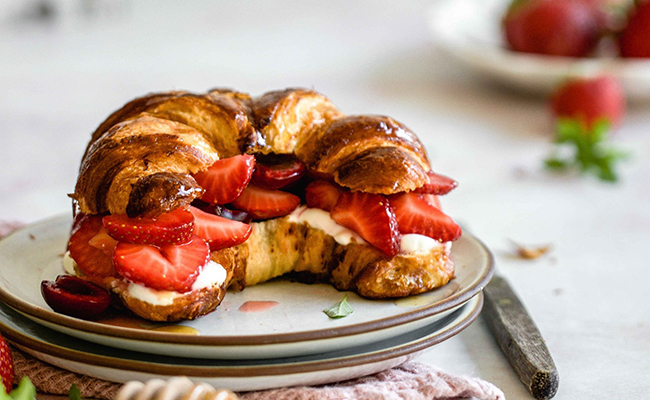

Explore the fruity side of croissants with fillings such as raspberry, apricot, or strawberry. These variations add a burst of tangy sweetness that perfectly complements the buttery richness of the croissant.
Now, let’s delve into the recipe for crafting the best homemade croissants, empowering you to create these flaky delights in the comfort of your own kitchen.
Recipe: Crafting Homemade Flaky Delights
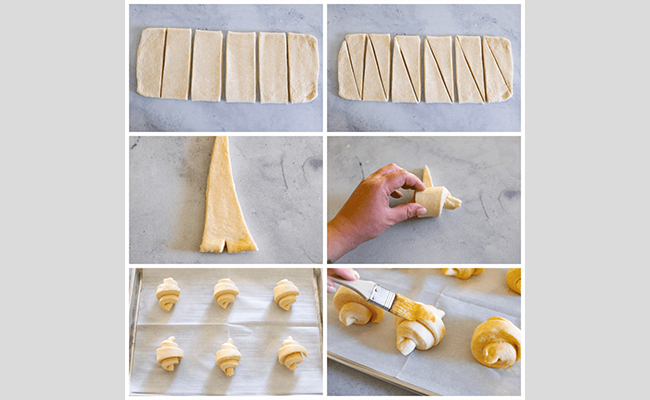

Ingredients:
- 2 ½ cups all-purpose flour
- ¼ cup granulated sugar
- 2 ¼ teaspoons active dry yeast
- 1 teaspoon salt
- 1 cup unsalted butter, cold and cut into small cubes
- ½ cup whole milk, cold
- ¼ cup water, cold
Instructions:
1. In a large mixing bowl, combine the flour, sugar, yeast, and salt. Mix the dry ingredients until well-incorporated.
2. Add the cold, cubed butter to the dry mixture. Using a pastry cutter or your fingertips, gently incorporate the butter until the mixture resembles coarse crumbs.
3. Create a well in the center of the mixture and pour in the cold milk and water. Stir until a shaggy dough forms.
4. Transfer the dough onto a lightly floured surface and knead gently for approximately 5 minutes, or until the dough becomes smooth and elastic.
5. Shape the dough into a rectangle and wrap it in plastic wrap. Place it in the refrigerator and let it chill for at least 1 hour.
6. After the dough has chilled, remove it from the refrigerator and roll it out into a large rectangle, about ¼-inch thick.
7. Fold the dough into thirds, like folding a business letter. Turn it 90 degrees and roll it out again into a large rectangle. Repeat this folding and rolling process twice more, ensuring the dough is chilled between each fold.
8. Wrap the folded dough in plastic wrap and refrigerate for another hour.
9. Preheat your oven to 400°F (200°C) and line a baking sheet with parchment paper.
10. Remove the dough from the refrigerator and roll it out into a large rectangle, approximately ¼-inch thick. Cut triangles from the dough, gently stretch them, and roll each triangle tightly from the wide end to the pointed end, shaping them into crescents.
11. Place the croissants onto the prepared baking sheet, leaving space between each one. Cover them with a clean kitchen towel and let them rise for 30-45 minutes, or until slightly puffed.
12. Once risen, bake the croissants in the preheated oven for 15-18 minutes, or until golden brown and delightfully flaky.
13. Remove the croissants from the oven and let them cool on a wire rack.
Now, take a moment to bask in the aroma of freshly baked croissants that fills your kitchen. Serve them warm, accompanied by a steaming cup of coffee or tea, and savour the buttery layers of perfection.
A Taste of Croissant Perfection
The croissant, born from a fusion of Viennese and French influences, has established itself as a globally adored pastry. With its flaky texture and luxurious buttery taste, it continues to captivate enthusiasts worldwide. Now armed with knowledge about its history, its regional variations, and a recipe to create your own, you can embark on a culinary adventure to savour the best croissants imaginable. Embrace your inner baker, roll up your sleeves, and revel in the joy of crafting these flaky delights from scratch. With each golden buttery bite, you’ll be transported to a world of culinary perfection. And for more delightful treats like croissants, explore a variety of cakes online to satisfy your cravings. Bon appétit!


